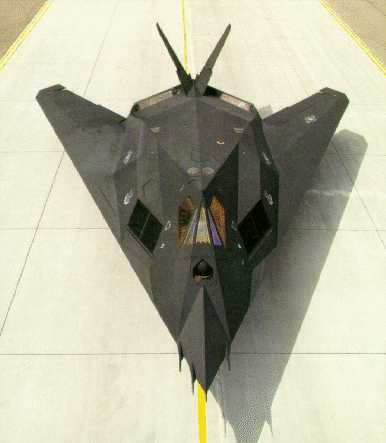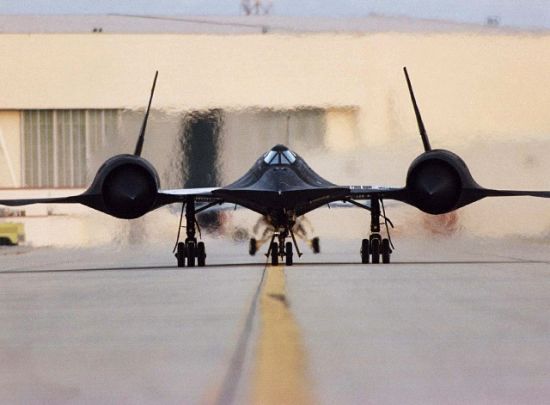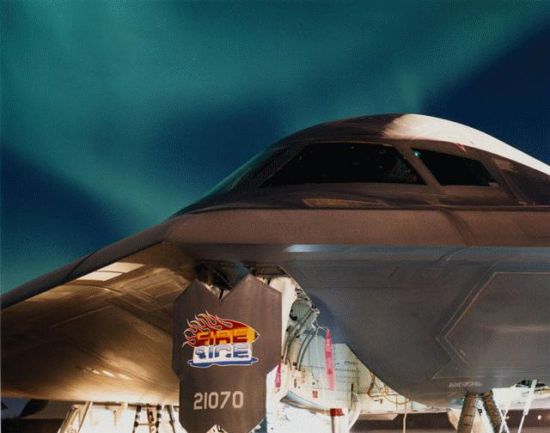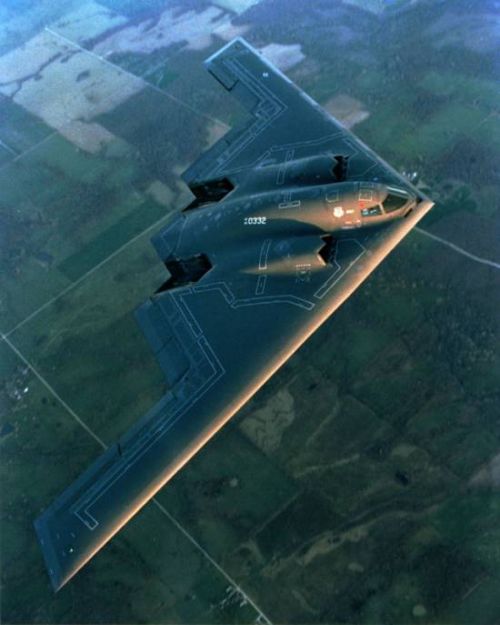|
||||||||||
|
|
||||||||||
|
||||||||||
|
|
||||||||||

Radar cross section (RCS):
Radar, short for radio detection and ranging, is an instument that sends out radio beams and then picks up reflected energy from aircraft, ships, or other objects to determine their location and speed. The range at which radar can detect an object is related to the power transmitted by the radar set, the fidelity of the radar antenna, the wavelength of the radar signal, and the radar cross section (RCS) of the vehicle. RCS, a measure of the radar waves scattered in a given direction, is the only variable an aircraft designer has any control over.
At first, designers tried to reduce RCS by placing various radar-absorbant coatings on the aircraft exterior. However, these coatings typically only produced minor reductions in RCS since many parts of a plane cannot be covered (cockpit windows and engines, for example). Designers soon realized the only way to make substantial redcutions in RCS was by carefully designing each portion of the aircraft to scatter radar waves away from their source. Some obvious solutions led to moderate reductions. For example, 90° corners and flat perpendicular surfaces were found to produce high radar returns, so designers rounded corners and used chined noses as well as canted vertical tails to reduce radar signatures. The Lockheed SR-71 Blackbird is an excellent example of these early efforts.

However, these modifications were only made when they did not interfere drastically with the overall performance of the design. Though the final product might have been more stealthy, it was still detectable. The revolution in radar stealth came in the 1970s when computers were powerful enough to solve the Maxwell electromagnetic equations for reasonably complicated shapes. These equations determine how radar waves are reflected and scattered, and by developing the capability to analytically predict the RCS of an entire aircraft from different angles, designers were able to drastically reduce the RCS. The major limitation of this early method was that it could only analyze flat panels. As a result, the F-117 and its Have Blue prototypes were composed of a number of faceted panels. The massive improvements in computer technology over the past two decades have allowed the same basic method to be applied to smooth, contoured surfaces. These improved codes have been instrumental in designing aircraft like the B-2 and F-22.
In addition to the overall shaping of the aircraft, a number of specific aircraft components can produce high radar returns. These include:

Infrared signature:
Along with radar, another major detection system used today is infrared heat sensors, such as night-vision goggles and infrared cameras. In addition, most short-range missiles like Sidewinder track heat sources, including aircraft engines. The key to reducing an aircraft's infrared signature is to cool the exhaust air rapidly using long nozzle ducts or mixing the exhaust with cooler air. The F-117 platypus nozzle, one of the more difficult items to construct, does both of these things. The Stealth Fighter also uses a high-bypass turbofan engine that mixes the hot jet exhaust with cooler bypass air. The B-2 and YF-23 also route the hot exhaust through long troughs coated with heat-absorbing material that not only help cool the air but block the hot gases from being seen from below.

Aural signature:
Aircraft are noisy, and all the fancy methods to reduce RCS or infrared-signature mean nothing when someone on the ground hears your plane roaring by. Since the F-117 is a high-altitude bomber, this issue isn't so critical, but high-bypass turbofan engines do tend to be much quieter than turbojets. Most stealth aircraft are also subsonic so they do not create sonic booms.
Visibility:
The ultimate level of stealth is to make the aircraft invisible to the human eye. Obviously, nothing developed to
date (that we know about) has achieved this extreme, but experiments to find methods of doing so are ongoing. The
most common and least sophisticated approach is through the use of camoflauge paint schemes. Light glinting off of
canopies can also be reduced using flat panels or special coatings. More sophisticated approaches revolve around
using lights or mirrors to bend beams of light around the aircraft making it more difficult to spot. However,
little information about this kind of research is publicly available. In addition, care must be taken to avoid
contrails, the white trails of condensed water vapor that can be seen in
engine exhausts. Cooling the exhaust goes a long way towards achieving this goal, and special fuel additives that
help eliminate contrails have also been developed.
- answer by Jeff Scott, 21 January 2001
Related Topics:
Why are the stabilizers on planes like the F-18 and F-22 slanted?
Read More Articles:


|
Aircraft | Design | Ask Us | Shop | Search |

|
|
| About Us | Contact Us | Copyright © 1997-2023 | |||
|
|
|||